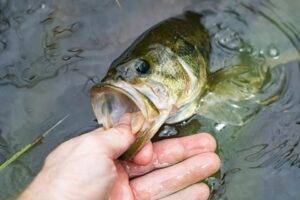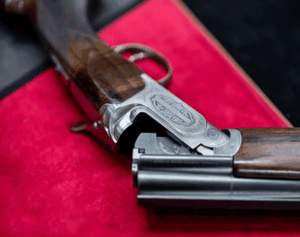

As an avid angler myself, trout fishing has been one of my favorite species to go after. I think there’s something about the relaxation with the thrill of catching fish that draws me in. Fortunately, I have learned a few things over the years that have increased my catch rates and filled my stringer time and time again. Let’s go over a few of these trout fishing tips for beginners in the following section so that you can catch your fair share of trout too.
Fishing Location is Key
As you plan your fishing trip selecting the right location is key. With so many rivers, lakes, and streams around, how are we to know where to start? It really comes down to water temperatures and time of year.
Trout don’t like warm water so let’s rule that out whenever possible. During the warmer months try and target bodies of water with movement or depth. These two things will naturally have cooler water temperatures. Trout will move to these areas when the air temperatures rise outside the water.
While Fishing in lakes for trout, fish near deeper water. Areas such as dams, levies, and deep channels are all places to find deeper cooler water.
Inlets to the lake provide cool water as well as fresh food. Inlets also provide better-oxygenated water as well which trout will love. Fishing trout lures in these areas are a quick way to catch a lot of fish quickly.
Another great place to catch trout are points. Points are a very undervalued area that often gets neglected by fishermen. Points are unique in that they allow us to fish at varying depth in a relatively short amount of time. At the beginning of every point, there are shallower tapering banks. The tips or the “point” may offer deeper colder water. Starting on one side of a point and fishing your way around it may unlock a clue as to where trout me be.
Best Bait for Trout
Trout baits can vary dramatically depending on where you fish and your local regulations. Always check local fishing laws to make sure we are legally and ethically taking fish.
Trout can have a very robust diet consisting of fish, insects, worms, crustaceans, and plankton just to name a few. Trout will predominantly feed on insects as the main source of food. Insects are ample and abundant in most places. This makes fly fishing an attractive alternative to bait fishing.
While trout can feed on small insects all day, they would much rather have a harder meal that they only have to work for one time. It’s all about energy exerted versus energy gained when trout feed. Larger meals such as minnows and worms are much more appealing to them. This is why most trout fishermen often fish with nightcrawlers or blood worms while fishing. Worms are easy to purchase at a local bait shop or gas station, and they catch fish.
Fish natural baits near the surface in the mornings and nights. Using a fishing float or bobber is a great way to accomplish this. Simply thread a worm or hook the dorsal fin of a minnow and let the bobber do the rest. This is a great technique to catch feeding trout that are actively feeding.
During the warmer hours of the day or mid-summer, fish on the bottom using an egg weight or split shot. Trout will hold closer to the bottom because of the cooler temperatures. Sinking a worm to the bottom is one of the best ways to catch trout. Use a worm inflator to add air inside the worm. Doing this will allow the worm to float slightly off the bottom in order to be more visible to the fish.
The last bait worth mentioning here is powerbait. Powerbait is an artificial dough bait that trout love. Dough baits are made in varying colors and scented with the same food that stocked trout are used to smelling. Fishing powerbait is a way to cast your bait out, sit, and wait. Dough baits can catch a lot of fish and allows you to relax in the process.
Trout Fishing Lures

If you’re looking to have a ton of fun, fishing trout lures are the way to go! Trout lures imitate smaller baitfish, and trout love baitfish as we discussed earlier. You can fish trout lures in lakes, rivers, and streams.
There are two types of lures that are most effective for trout. To catch greater numbers of fish I turn to spinners. Spinners are lures that have a blade that spins around creating flash and vibration. The second lure is one I use to catch larger fish and that is a minnow style lure. These are hard-bodied lures in the shape of a fish. These lures prevent a larger hardy meal for trout and large fish would much rather eat this that a small tiny little fly.
It is important to use a snap swivel no matter which fishing lure you decide to use. Swivels allow the lure to spin with the lure in the water preventing line twist. Without a swivel, your line will be a tangled mess after about 5-10 casts.
As a side note don’t be afraid to add scents to your fishing lures. Scents are a thicker liquid that you can drip or smear onto your lure body. You want to appeal to as many senses as possible while fishing. Trout love garlic and anise scents and these are the two I would recommend.
Other Trout Fishing Tips to Consider
While the above sections are critical to really break down and consider, there are a few other tips that could prove to be useful to you as well.
Watch for changing weather patterns. Cold fronts moving in after a long period of warmer weather is a key indicator that trout may be active.
Use natural baits caught near or in the water. Again making sure we’re following local regulations, catching food within the immediate ecosystem of the trout can provide great results. This is the food that trout eat on a day to day basis, let’s not get too fancy and give it to them.
Casting parallel to the bank to remain in the strike zone. You will find the trout will feed at a particular depth. Oftentimes it will be near the shoreline as they chase baitfish up to the shoreline. I have had great success cast at a 30-45 degree angle to the shoreline. This allows my lures to remain in the vital area that trout are feeding.
Fishing line is another thing that often gets overlooked. While bait fishing for trout I never use line greater than 10-pound test while fishing for your standard rainbow and brown trout. If you know there are larger fish lurking you may want to move up to 12-14 pound test. I will use the smallest line diameter I can get away with, for me, this is right around the 6lb test mark.
Conclusion
It’s my hope that you have learned something here today. Fishing is a passion of mine and it is my goal to spread that passion to others. Remember that while trout fishing temperature and food are the two main driving factors to finding success. You must constantly adapt and change your plan as the day progresses. Knowing how and when to adapt will be the key to catching more trout and filling that stringer.








